The Rise of the Station Wagon
 This article and other features about the golden era of American cars can be found in the Post’s Special Collector’s Edition, American Cars: 1940s, ’50s & ’60s.
This article and other features about the golden era of American cars can be found in the Post’s Special Collector’s Edition, American Cars: 1940s, ’50s & ’60s.
The versatile station wagon, nearly extinct today in the shadow of the roomier SUV, became a must-have, all-purpose form of family transport in peak years of the baby boom.
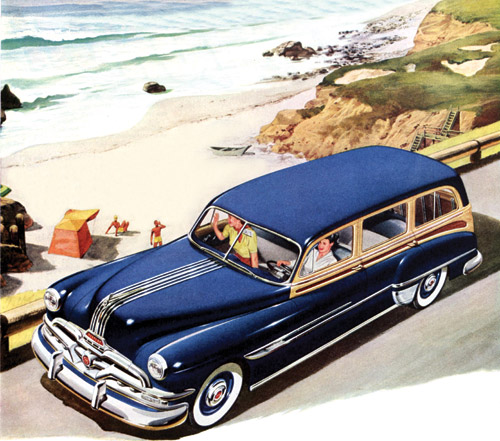
General Motors, August 9, 1952
—“From All-American Automobile,” originally published May 26, 1956
In the year 1955, Robert W. May, of Brandon, Mississippi, achieved a stirring statistic. Completing his 20th year as a Chevrolet dealer, he sold more station wagons in 12 months than he had sold in all the preceding 19 years put together. In Doylestown, Pennsylvania, Jenks Watson was rather surprised to find that in the first two months of 1956, 40 percent of his Plymouth and Dodge deliveries were station wagons. A similar percentage for the same period was recorded by Cottrell-Anderson Pontiac agency in Flemington, New Jersey, while in Salinas, California, Cochran Motors discovered that in 1955 one of every five Fords sold was a station wagon, a percentage that quadrupled the company’s 1951 figure.
The unusual thing about these better-than-average performances is that they are not rarities. They are simply random evidence of the sharpest and possibly the most significant recent swing in the history of automobile tastes — the whopping rise of the station wagon. The horse may be gone, but this is certainly the day of the wagon. Here are the measurements of the phenomenon: Before the war, the automobile-manufacturing industry in no single year ever made as many as one station wagon in every 100 cars
produced, and even in early postwar years the ratio was little more than 1 in 50. Today at least every 10th car manufactured is a wagon. In the low-priced field, the station wagon of one company accounts for every second car produced, and in others a wagon is every seventh or eighth or ninth. Last year the volume of wagons came within 10 percent of doubling the preceding year, and it is more than probable that new records will be set in 1956, certainly in the percentage of wagons to total cars.
Automobile manufacturers know a million reasons for the surge, most of them good, none of them quite precise. However, it is seldom denied that four factors are especially important. They are the adoption of all-metal bodies, suburban living, the new American leisure, and babies.
More wagons are showing up on rural-mail routes, and the wagon as a troop transport for Cub Scouts and Brownies is well established. One of the Big Three manufacturers learned this latter fact the hard way in 1953. In that year, the maker, for unknown reasons, dropped its three-seat, eight-passenger wagon, offering nothing but a two-seat, six-passenger model. An angry host of housewives promptly made it clear that the missing third seat had a basic capacity of three Cubs and, allowing for squeeze and lamination, a potential of at least twice that many. The manufacturer sorrowfully marked 1953 as “the year of the den mothers’ revolt” and hastily introduced a new nine-passenger wagon.
Unlike the mule, the station wagon has at least partial pride of ancestry and a glowing hope of posterity. It bears the lineage of rich estates where in past decades it denoted a family that not only could afford an extra car for guest hauling but also had servants to keep the wagon’s wooden panels varnished and, for as long as possible, unrotted and unsplintered. As it is made today, the station wagon is roughly two-thirds a standard car of its particular line, identical with its companion sedans as far back as the middle-door pillar. From there on back, the roof continues relatively straight instead of dropping down to provide a low cover for a luggage-and-spare-tire compartment. It is common, also, for the wagon to be more heavily sprung in the rear. An extra spring leaf or two may be added, or heavier coils, or, as in one case, helper springs. The tires frequently have more plies or are of different size.
The station wagon is a logical automobile. On the same frame as a coupe, for example, it carries more than just a cupola on its foundation, but roofs over the entire serviceable riding area. The surprising fact is that this total space was not used in all cars from the very beginning. For, in the eyes of a space engineer, pulling a roof down to make a low cover for a trunk space is like throwing away a potential room in a house.

Go Bananas with These 101-Year-Old Recipes
Once considered “the poor man’s fruit,” banana prices are on the rise in 2018. If you’re going to splurge on the botanical berry, why not make it count? Here are 13 ways to “daintily prepare and serve” the cooked banana, circa 1917:
—
When Food Costs Soar
Originally published in The Country Gentleman, April 14, 1917
Every wise housekeeper is on the outlook nowadays for ways and means of cutting the high cost of living. With eggs soaring in the 40s and butter in the same locality and the high prices of other things, it behooves womankind to put on thinking caps.
Bananas, frequently spoken of as “the poor man’s fruit,” are well deserving of this title, as they may be purchased at a reasonable price at all seasons of the year. Comparatively few people, however, know the value of the cooked banana, which is truly delicious, when daintily prepared and served as a dessert, vegetable, or supper dish.
Banana Fritters

Beat the yolk of one egg and add half a cupful of flour into which has been sifted a teaspoonful of baking powder; add a teaspoonful of sugar, a teaspoonful of olive oil, and lastly, the well-beaten white of the egg. Cut bananas in two lengthwise, then crosswise, squeeze lemon juice over each piece, dip in fritter batter, and fry in hot fat. Drain on paper, sprinkle with powdered sugar, and serve hot.
Fried Bananas
Select firm and rather slender fruit, peel and cut into sections about three inches long. Fry in hot butter, and as the bananas cook, sprinkle with a little sugar and roll about carefully in the frying pan until a light brown all over. Transfer to a hot dish, pouring over them any butter that may remain in the pan. Serve at once.
Bananas Fried in Deep Fat

Remove the peel and coarse threads from four or five bananas and cut the fruit in thin slices. Dip these slices in milk, then dredge lightly with salt, paprika or pepper, and flour. Cover the bottom of the frying basket with the slices and immerse in hot fat. Cook until light brown. Let the slices drain on a piece of brown paper before sending to the table. These can be served as the main food at supper or lunch.
Baked Bananas
Remove skins from six bananas and cut in halves lengthwise. Put in a glass baking dish. Mix two tablespoonfuls of melted butter, one-third of a cupful of sugar, and two tablespoonfuls of lemon juice. Baste the bananas with half the mixture. Bake 20 minutes in a slow oven, basting frequently during baking with the remaining half of the mixture.
These are very much like candied sweet potatoes and can be served in place of them.
Banana Croquettes

- 1 cupful of sweet milk
- 1 egg
- 1 cupful of flour
- 1/4 teaspoonful of salt
- 1 teaspoonful of baking powder
- 1 banana
- 1 teaspoonful of sugar
Slice the banana thin and stir it into the batter. Drop one spoonful at a time and fry in deep lard. Serve as a vegetable, or a sweet with maple sirup.
Banana Cakes to Be Served with Meat
Select a good-sized banana for each person to be served. Mash each banana with a fork, sprinkle with salt, mix with cracker crumbs, pat out on a board, cut in squares, and brown in a very little fat.
Note: When mixing, be careful to break the fibrous part of the banana so that the pulp is of the proper consistency for making into cakes.
Banana Loaf
Select a small loaf or sponge cake or of angel food, and cut a well in the center. To do this, press a thin tumbler through the center of the loaf, almost to the bottom, then remove the crumbs within the circle left by the tumbler. Fill this hollow with sliced bananas and whipped cream sweetened to taste.
Bananas Baked Whole
Remove peel, dip in lemon juice, roll in fine sifted crumbs. Place in baking pan and bake 15 minutes in hot oven. Serve with whipped cream, sweetened, and flavored with cinnamon.
To vary sliced bananas served with cream and sugar, use lemon sirup over them — the juice of half a lemon and two teaspoonfuls of sugar. This quantity is sufficient for two small bananas.
Banana Pie

Line a pie tin with rich crust. Make a nice custard after your favorite recipe; flavor it with lemon, and add one large banana, chopped fine. Fill the crust with the custard and banana and bake until well set. Let it cool, then pile on top a meringue made from whites of eggs, powdered sugar, and lemon juice. Place in oven until a delicate brown.
Another Banana Pie
- 1 cupful of sugar
- 1 teaspoonful of butter, not melted
- 2 eggs
- 2 tablespoonfuls of flour
- 3/4 cupful of boiling water
- vanilla
Line a deep plate with rich crust and bake to a delicate brown. For filling, cream together the sugar and butter, and then beat in the yolks of eggs and flour, add water and cook, stirring constantly until thick. Add a little vanilla to taste. After cream is cool, slice bananas and fill bottom of pie, covering with cream, then another layer of bananas and another of cream. Put in oven and bake. Cover with beaten whites of the eggs and bake to a delicate brown.
Peaches or oranges may be substituted for the bananas, sugaring them for about one hour before using.
Banana Pudding
- 2 bananas, cut small
- 1/2 loaf of bread, crumbed
- 1/4 of a cupful of sugar
- 2 tablespoonfuls of butterine [imitation butter made with animal fat]
- 1 egg
- 1 cupful of milk
Mix all together and bake 30 minutes.
Scalloped Bananas
Cut half a dozen bananas into half-inch slices. Cut some bread into small pieces, and put a layer of this into the bottom of a buttered baking dish. Add a layer of bananas and half a tablespoonful of lemon juice. A sprinkle of sugar may be used. Repeat these layers until all have been used, having bread as the top layer. Sprinkle the top with sugar, and bake for 30 minutes in a quick oven.
Banana Puffs
For puffs
- 2 eggs
- 1 cupful of milk
- 1 cupful of sifted flour
For pulp
- 2 or 3 large bananas
- 1 orange
- 1 teaspoonful of sugar
Beat the whites of the eggs to a stiff froth. To the yolks add the milk, which should be very cold, and a pinch of salt. Mingle thoroughly with a batter whip, and add slowly one cupful of sifted flour, beating vigorously. Lastly add the whites of eggs, lightly folded or chopped in, and then pour this batter into hot gem irons, and bake in a quick oven. If right, they will double their size and be nearly hollow. Fill with banana pulp.
To make this pulp, remove the skin from two or three large bananas, press through a wire strainer, add a teaspoonful of sugar, and the juice of one orange. Beat thoroughly with a fork.
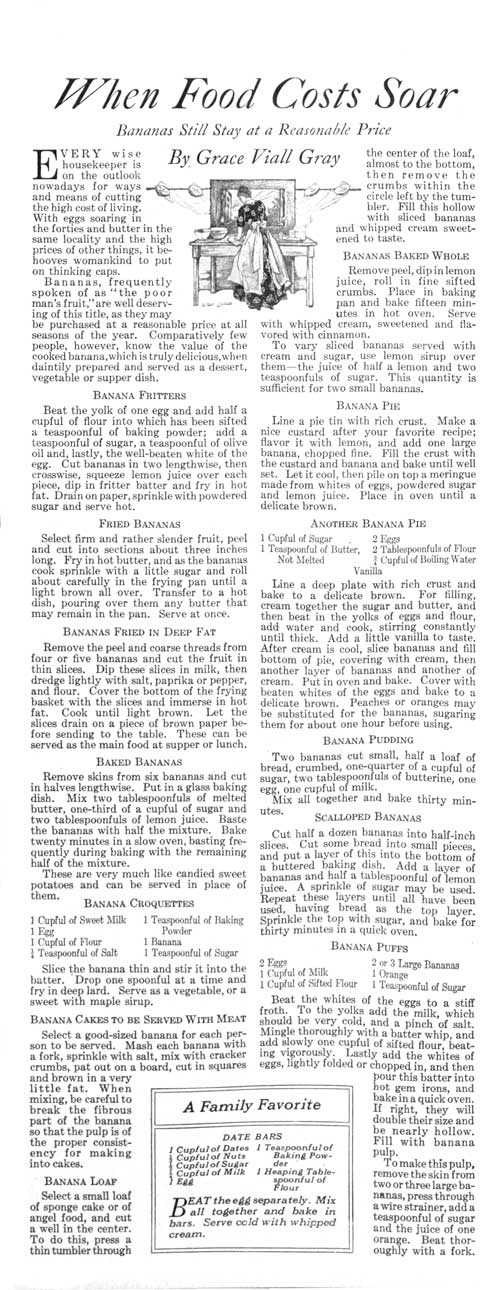
Healthy Weight, Healthy Mind: The Bad Smell of Stinkin’ Thinkin’
We are pleased to bring you this regular column by Dr. David Creel, a licensed psychologist, certified clinical exercise physiologist and registered dietitian. He is also credentialed as a certified diabetes educator and the author of A Size That Fits: Lose Weight and Keep it off, One Thought at a Time (NorLightsPress, 2017).
Do you have a weight loss question for Dr. Creel? Email him at [email protected]. He may answer your question in a future column.
In this article, we’re exploring how the relationship of thoughts, feelings, and behavior affect our eating and exercise habits. Thinking takes center stage.
Before we get started let’s clarify a few concepts and terms. Each of us has thoughts we can’t entirely control. Sometimes we know certain thoughts are ridiculous and we can easily dismiss them and ask ourselves, “Where did that come from?” We won’t be scrutinizing those thoughts. Instead, I want to focus on thoughts that matter — the ones that influence behavior and shape our attitudes and beliefs.
Beliefs are simply thoughts we accept as true. If your mind was a garden, thoughts would be seeds that quickly developed into seedlings. Beliefs and attitudes are the mature plants. Therefore, thoughts are full of potential to help us and provide a sense of well-being. Too often, however, they derail us — and that’s where this chapter can help. Let’s look at three clients whose thinking directly affected their attempts at weight loss:
- John needed to make changes in his diet before being approved for bariatric surgery. As I explained the MyPlate principles of healthy eating, John snapped back at me, “I’m not doing that. Nobody eats that way!”
- A client named Karmen told me her personal trainer said she was obese because she’d ruined her metabolism. According to him, regular, intense workouts were the only way to solve her weight problem.
- Becky’s mother always told her she’d never find a good man if she was overweight. Now 32 years old, 75 pounds overweight, and still single — Becky felt unlovable.
Can you see how John, Karmen, and Becky handicapped their weight management efforts before they even started? John’s belief that only freaks would eat a balanced diet was like putting up a huge DETOUR sign on the road to weight loss. Karmen was overwhelmed by thinking her metabolism was forever ruined, and only a lifelong extreme exercise program would treat her condition. She was bound to give up. Becky’s mother primed her to feel lonely and hopeless in pursuit of a relationship. She quickly dismissed any man who showed interest in her, yet paid close attention if anyone seemed put off by her weight. Eating would become her friend, her solace.
These three examples above show how thinking can have a clear, direct relationship to weight. However, sometimes the beliefs that affect eating and physical activity are more subtle and indirect:
- At work, Steve’s philosophy was, “If I don’t do this, it won’t get done.” At the same time, he had high standards for work and wouldn’t delegate tasks to others. This led to 14-hour days with no time for exercise. Being strapped for time and chronically sleep deprived, he often ordered carry-out and drank caffeinated sugar- sweetened beverages all day long.
- For years Sarah tried not to even think about her family, but she couldn’t get them out of her mind. Her alcoholic father’s relapse made her both angry and sad. Her sister’s lifestyle choices led to financial problems, and Sarah felt obligated to help. Sarah seemed to always feel upset, and to keep those emotions under control she distracted herself in some way — often by eating something she knew she shouldn’t.
- Lisa often thought about how terrible it would be if she disappointed her boss, her husband, or her kids. She believed she needed to be everything for everyone, and this led to anxiety she couldn’t control. She felt anxious much of the time and eating became her Xanax.
The First Steps Toward Change
The first step toward thinking differently is to recognize beliefs and feelings behind the behavior we want to change. Examining situations and their outcome helps pinpoint our problematic behavior. For example, let’s consider Lisa from the last paragraph and imagine how she might respond to the following scenario:
Lisa’s boss asks for a volunteer to lead a fundraising project (situation). Lisa thinks, “My boss will be disappointed in me if I don’t do it,” (thought) and despite her already overcommitted schedule, she feels pressure (emotion/feeling) to take on the task. For Lisa, this becomes a question of which option is most unpleasant: the anxiety of not volunteering versus the anxiety and stress of accepting extra work she doesn’t want. Either way, she feels stressed because her thinking has created a lose-lose situation.
Lisa could think differently: “I’m not sure what my boss expects, but even if he does want me to do this (and I have no evidence that he does), it’s unreasonable for me to be everything for everybody. Other people in the office can benefit from taking a turn. The people who truly care about me will still feel that way even if I don’t always do exactly what they want.” She could also talk to her boss in private about his expectations. Thinking differently helps Lisa feel less anxious about her situation. Her new thinking may feel awkward at first but allows her to make the brave choice of saying “no” to more responsibility.
News of the Week: The Time 100, Time Travelers, and 21 (Supposedly) Overrated Books
Influential People
For the 14th year in a row, I just missed making the Time list of the 100 most influential people in the world. This year I came in at 107, and so was not invited to the big party they had Tuesday night announcing the list. I was busy that night anyway. I had pasta and watched Jeopardy in my sweatpants.
The list is divided into different groups: “Pioneers,” which includes the kids who survived the Parkland school shooting; “Artists,” which includes Roseanne Barr and Jimmy Kimmel; “Leaders,” which features President Trump and Meghan Markle; “Icons,” which includes Jennifer Lopez and Kesha; and “Titans,” a category that features Roger Federer and Oprah Winfrey.
I’m not sure why Cardi B is considered a “Pioneer” and not an “Artist,” but I’m sure Time has its reasons. Also, I thought Cardi B was a prescription heart medication.
The Grandfather Paradox
Speaking of time…
I’m not a scientist (or an Icon or Pioneer), so maybe I’m wrong, but I don’t think that time travel can exist. Let’s say you went back in time to stop yourself from accidentally drinking some expired milk. If you stop yourself from drinking the milk, then it didn’t happen, and if it didn’t happen, then how did you know about it in order to go back in time to change things? Of course, this can be explained by alternative timelines and other things that we’ve heard about in science fiction, but it still doesn’t seem to me that it could logically work.
But it’s a fantastic narrative device that movies and TV shows keep using, from Star Trek and Quantum Leap to one of my favorite current shows, Timeless. And according to Slate’s “Watch Smarter” series, there are movies and TV shows that get time travel right and some that get it completely wrong. They say that Back to the Future gets it wrong, while The Terminator gets it right.
But their examples, to me, seem a bit contradictory or open to opinion, insomuch that nobody knows how time travel would work (and wouldn’t we be visited by time travelers right now if it does exist in the future?). Read some of the comments on the piece and you’ll see how some readers disagree with Slate’s findings.
If I had a time machine, I’d go back to a certain Tuesday night in 2003 and prevent Mark Zuckerberg from getting drunk.
Nancy Is Back!
Actually, the comic strip Nancy never really went away. It was drawn by Ernie Bushmiller until 1982, and then by other artists until earlier this year. A new artist, with the pseudonym Olivia Jaimes, took over the strip a few weeks ago, and a lot of fans aren’t happy at all with the new direction the strip has taken.
Nancy and Sluggo are now a little more modern and hip. They’re always on their smartphones, watching Hulu, and dealing with social media and video games. There seems to be a change in the tone of the strip as well. Luckily, they’re still dressed the same, Nancy with her skirt and the bow in her hair and Sluggo dressed like a 1930s hobo.
I’m just happy that newspaper comic strips still exist and people are actually invested enough to argue about them.
Overrated?
Every day, there are dozens of terrible, inaccurate, misguided, and just plain dumb articles posted online. This, from GQ, is one of them.
It’s titled “21 Books You Don’t Have to Read,” so you know right away that it’s going to make you grit your teeth. It’s a list of overrated books, with helpful suggestions on what you should read instead. Don’t read Catcher in the Rye by J. D. Salinger, read Olivia: A Novel by Dorothy Strachey instead! Forget about that lame Adventures of Huckleberry Finn by Mark Twain and dive into Narrative of the Life of Frederick Douglass, An American Slave, by Frederick Douglass! The Bible? That’s sooooo several centuries ago. Instead, read The Notebook by Agota Kristof!
It’s a weird, clickbait-ish piece, because it not only dumps on a lot of classic books, explaining how they’re “overrated” and/or not well-written, but also discourages people from reading them in the first place. As if the philistines at GQ know what you “should” read.
I happen to live in a world where you can actually name 21 books that everyone should read without also listing 21 that you shouldn’t. More reading, not less.
Who Was Mister Peepers?
I don’t talk about politics a lot in this column (that seems like the road to madness), but President Trump did allegedly do something recently that I thought was worth mentioning in a pop culture context. Reports say that he has nicknamed Attorney General Jeff Sessions “Mr. Magoo” and Deputy Attorney General Rod Rosenstein “Mister Peepers.” Most of us know who Mr. Magoo was, but I bet a lot of people under the age of 50 aren’t quite sure about this Mister Peepers guy. I heard one anchor this week call him a cartoon character.
Actually, Mister Peepers was a character in the NBC comedy of the same name, played by Wally Cox (later the voice of Underdog). Mister Peepers aired from 1952 to 1955. Here’s an episode:
https://youtube.com/watch?v=emmyJV9tr50
RIP Verne Troyer, Bruno Sammartino, Avicii, Reid Collins, Lee Holley, and Bob Dourogh
Verne Troyer was best known for his role as Mini-Me in the Austin Powers films. The actor also appeared in other movies, including Fear and Loathing in Las Vegas. He died last week at the age of 49.
Bruno Sammartino was a Hall of Fame professional wrestler who later became an announcer. He died last Wednesday at the age of 82.
Avicci was a DJ and electronic dance music star known for his song “Wake Me Up.” He died last week at the age of 28.
Reid Collins was a veteran newsman and anchor who worked for CBS News from the mid-’60s to the mid-’80s and then joined CNN as an anchor. He died last week at the age of 88.
Lee Holley was a cartoonist known for his strip Ponytail, which focused on the life of a teenage girl. He also worked on the Dennis the Menace strip, and drew many classic characters for Warner Brothers. He died March 26 at the age of 85.
Bob Dorough was a jazz musician who composed and performed the classic Schoolhouse Rock! songs for ABC. He died Monday at the age of 94.
https://youtube.com/watch?v=RPoBE-E8VOc
Quote of the Week
“I’m perfectly willing and happy to step aside or help transition it into something new.”
—Simpsons voice actor Hank Azaria, on the controversy over the cartoon’s depiction of convenience store owner Apu
This Week in History
Red Baron Shot Down (April 21, 1918)
He wasn’t just a frozen pizza or Snoopy’s arch-enemy. He was a real World War I German flying ace named Manfred von Richthofen. He was killed in battle over northern France.
“New” Coke Debuts (April 23, 1985)
The new soda formula was launched with a massive ad campaign that included TV commercials featuring Bill Cosby and Max Headroom. Coke fans quickly let the company know that they didn’t want Coke changed, and just a few months later, the company “reintroduced” the original formula as “Coke Classic.”
This Week in Saturday Evening Post History: Weatherman Was Right (April 27, 1946)
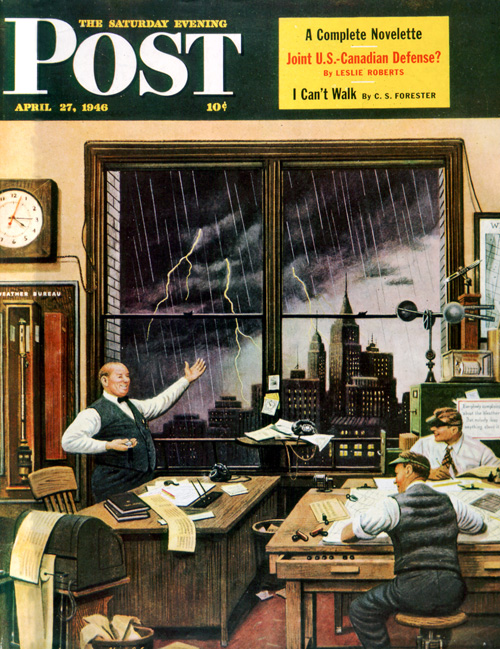
Stevan Dohanos
April 27, 1946
The meteorologists on this Stevan Dohanos cover seem very happy that their prediction of rain and lightning came true. April showers bring May flowers and all that.
Antiques Roadshow and the Post
I watch PBS’s Antiques Roadshow every week. I’m not only interested in the history of the items that people bring to be appraised; I also look for items that might be connected to something I own, a place I’ve worked, or where I was born. Just last month, they featured a painting of an area that’s about two blocks from where I live. The funny thing about it was, even though the area looks completely different now and didn’t feature anything I recognized, I knew it was my town the second they showed the painting.
On this week’s episode filmed in Green Bay, Wisconsin, a man brought in a bugle (in this video at the 38:30 mark) that was owned by his great-great-great-grandfather Seth Flint, who was General Ulysses Grant’s escort bugler. Flint actually wrote an article for the Post back in 1930 about his adventures, titled “I Saw Lee Surrender,” which you can read here.
Raisins, Raisins, Raisins!
This is a very exciting time to be a raisin. Not only is this Monday National Raisin Day, next week is National Raisin Week. So here are some recipes that feature pickles.
Just kidding! Here’s a recipe for Cinnamon Raisin Bread, and we also have a whole page filled with retro pie recipes from the ’50s, including an Orange-Raisin Pie.
Next Week’s Holidays and Events
Older Americans Month begins (May 1)
The Administration on Aging heads this celebration every May. This year’s theme is “Engage at Every Age.”
Bird Day (May 4)
This is a confusing day, because while Bird Day falls on May 4, International Bird Day is on April 13. And if that wasn’t enough to remember, International Migratory Bird Day is held the second Saturday in May.
None of these celebrations should be confused with Larry Bird Day, which was announced by Indiana’s then-governor Mike Pence on November 9, 2013.
January/February 2018 Limerick Laughs Winner and Runners-Up

The students were taught by a master
But the dance class became a disaster
Cried one little mister,
“I’m paired with my sister!”
“So can’t we please dance any faster?”
Congratulations to Linda Neukrug of Walnut Creek, California! For her limerick describing Albert W. Hampson’s illustration Cotillion, which appeared as a Post cover on May 23, 1936, Linda wins $25 and our gratitude for a job well done.
If you’d like to enter the Limerick Laughs Contest for our upcoming issue, submit your limerick via our online entry form.
Linda’s was only one of a bunch of great limericks! Here are some of our favorites from our runners-up, in no particular order:
We’re lined up, all in our places
To practice polite social graces.
Some day this dance
May lead to romance,
But today we’d rather make faces.—Christine Coates, New Berlin, New York
They went to the junior cotillion,
Where she wore a dress of vermillion.
But what are the chances
These kids have more dances?
I’d say about one in a million.—Pat Cunningham, Cheektowaga, New York
They’ve probably practiced all day
To perform in this delicate way,
But the two kids in front
Add their own little stunt
To an otherwise perfect display.—Chet Cutshall, Willowick, Ohio
Dad said, “Just so that we are clear,
You will dance with your sister this year,
Or lose, if you like,
The use of your bike,”
Which explains the real reason I’m here.—Paul Desjardins, West Kelowna, British Columbia
The children’s performance was fine,
Their costumes and dancing divine.
One had to award ’em
High marks for decorum
… Except at the front of the line.—Michelle Gordon, Airway Heights, Washington
The French master’s class in the dance
Quite often would spark a romance.
But Sally and Sonny
Are nobody’s honey!
Which shows in their combative stance.—Lynn Johnson, Green Valley, Arizona
This girl who is dressed up in pink
Doesn’t know quite what to think:
Does this boy really hate her
Or wish he could date her?
She’ll obsess about this with her shrink.—Neal Levin, Bloomfield Hills, Michigan
“Excuse me, there’s no time to laugh.
Bow and curtsy and straighten the calf.
This is a cotillion;
You will look like a million
Or my salary will likely be half.”—Dolores M. Sahelian, Mission Viejo, California
In the ballroom, the young are taught graces
And how to trade spats for embraces,
But whether waltz or quadrille,
There are boys and girls still
Who wish only to trade nasty faces.—Rebecca Shulman, New Hope, Pennsylvania
Movies for the Rest of Us with Bill Newcott: The Tribeca Film Festival
Movie critic Bill Newcott reviews the hottest movies from the Tribeca Film Festival, including documentary Love, Gilda and The House of Tomorrow starring Ellen Burstyn. Bill also reviews the latest home video releases, including Film Stars Don’t Die in Liverpool with Annette Bening, Hostiles with Christian Bale, and 12 Strong with Chris Hemsworth. Plus, don’t miss the 40th (!) anniversary of Grease, out in a new Blu-ray anniversary edition.
See all of Bill’s movie reviews.
The Bicycle
A little past five, I stood at the stove. Footsteps sounded on the front porch, a whir of wheels, the rattle of a chain, and the snap of a lock. The front door opened, and someone crossed the living room. Wearing a quilted down vest and a helmet, Laurel stood in the archway.
“Good evening, darling,” I said.
“Hi, Wes.”
“Nobody is going to steal a bicycle in Hapsburg.”
“Better safe than sorry.”
Laurel shook loose her long brown hair. She leaned over the stove and took a deep breath. “That smells good. What is it?”
“Split pea soup with onion and garlic.”
“What are the orange bits?”
“Grated carrot.”
She was flushed and smiling, teasing me.
“It’s traditional,” I said, “like chocolate chips in a cookie. You know me, I’m all about tradition.”
“Except when you’re not.”
Her cheek was so close, I couldn’t resist a peck.
“You’re wearing the new chef’s apron,” she said.
“Since you bought it for me.”
“After you bailed me out. To make amends.”
“There’s nothing to make amends for.”
“Then consider it a token of my appreciation. You didn’t say ‘I told you so.’”
“I’m still not. But I do want to know.”
“In return for my cooperation,” Laurel recited, “the campus police let me off the hook. I gave names and addresses of the other protesters.”
“You squealed.”
“What else could I do? The college library still fired me. There’s a clause in the employee guidelines about destruction of property.”
I held the spoon so she could taste the soup.
“The apron makes you look so clean and …”
“Like I know what I’m doing?”
“That too. You smell like fresh laundry.”
“Speaking of which …”
“I know, the hamper is full and the laundromat is lonely.”
“Chores. That was our agreement.”
“Anyway, you are a good cook, so enough false modesty.” She stepped back, unzipped her vest, and sat backward in a chair to face me.
“How was the first day at the new job?” I stirred the pot of soup. As we talked, I chopped vegetables and set the skillet over a flame.
“Wonderful! The public library is exactly what you expect in a small town, old and quirky, with lots of windows and natural oak. My boss Hazel Lampwick is a dear! She grew up here, always wanted to be a librarian. I would guess she’s 40-ish.”
“The same age as me. We went to school together.”
“Really and truly?”
“No lie.”
“Miss Lampwick asked me to read aloud in the afternoon to the preschoolers. So, in addition to my menial tasks, I’m the new story lady. I started to read a book, but a squirmy little boy interrupted me after the first sentence. ‘We already read that one,’ he said. I tried another book, and he cut me off again.”
“So what did you do? Smack him?”
“No, Wes! I made up a story.” Laurel’s eyes shone.
“Aren’t you supposed to promote the written word?” I finished chopping and was about to sauté the vegetables.
“There’s no job description.”
“Besides, you told me you’re a terrible liar.”
“Telling a story is not the same as lying. It’s an art form.”
“An old Southern tradition.”
“Are people from Missouri allowed to tell stories?”
“Missouri is a border state.”
“Anyway, as I rode home on my bicycle, I passed the courthouse green, and I had to stop. Sunlight was fading, and clouds were turning a dull purple. Small birds flew as a flock around and around.”
“Swallows.”
“Lights came on in the houses. It was like watching a movie. I watched a man come home from work. I imagined his wife inside cooking dinner, children setting the table. They had to set an extra place for a visitor. Then it hit me — I was going home, too. Except instead of Mrs. Whatsit, you were in the kitchen.”
“And the children stayed at the library.”
Laurel laughed.
“You should write about what you saw.”
“Oh, Wes, the subject is too much like my college poems. I don’t want to write something moody.”
“Then don’t. Paint the picture and tell the story.”
“I don’t even know what the story is.”
“Surprise yourself. Do it tonight, while the experience is fresh.”
“Should I include the bicycle?”
“Beats me. I never rode one.”
“Seriously?”
“I grew up dirt poor, Laurel. We lived in an old plank house with a rock fireplace. There was one bedroom for grownups. Children slept in the attic.”
“Where was this?”
“Out in the county.”
“Did you at least have indoor plumbing?”
“We fetched water from a spring and used a privy to answer the call of nature.”
“Your childhood home makes Missouri look progressive.”
“To make matters worse, my parents passed away in their 30s. I was the youngest. My sister helped raise me as long as she could. She got married, and then it was every man for himself. I got my first job as a teenager, when I was still in school.”
“Where are your siblings now?”
“Gone or moved away.”
“Are you the last of the Grubbs?”
“Not hardly. There’s always more lurking in the backwoods of Virginia. But you see how we couldn’t afford extras.”
“Like new clothes and fancy toys.”
“And bicycles.”
“And that’s why you never learned to ride.”
“Now it’s too late.”
“Don’t say that! Better late than never. I’ll teach you.”
“On what?”
“You can ride my bicycle.”
“What if I crash and wreck it?”
“Wes, this isn’t like you. After supper, we’ll go outside for your first lesson. I’ll hold the handlebar and run alongside. You’ll see. It’s as easy as …”
“Falling off a log?”
After supper, Laurel dragged me out to the porch, unlocked her bicycle, and lifted it down the steps to the street. The last gasp of daylight was gone by then. A streetlamp flickered from an old utility pole that oozed tar and leaned like it was tired. Perched on the skinny bicycle seat, high above those skinny wheels, I tilted and wobbled.
“Feet on the pedals, look straight ahead.”
“I feel like a bear in a circus.”
“Once you get moving, it’s easier to balance.”
“It’s too dark to see where we’re going.”
“There’s no traffic in the street at this hour. We’ll be fine.” She panted as she ran.
Laurel lost her grip, and I spurted ahead. I struck a pothole, went down, and landed on my left elbow.
“No!” Laurel wailed as she scrambled to where I lay. “Are you hurt?”
“It’s a good thing I’m right-handed.”
“This is all my fault!”
“Give me a hand up. Ouch!” The agony was beginning.
“Your sleeve is ripped.”
“What about the bicycle?”
“It looks okay. Maybe a scratch on the paint.”
“How bad is my elbow?”
“Something white is showing. I think the bone is exposed.”
“What about blood?”
“Not too much.”
“That’s good, because I can’t stand the sight of blood. Especially when it’s mine. Can you look in the medicine cabinet?”
“I don’t know anything about first aid.”
“Maybe there’s some iodine or hydrogen peroxide.”
“Should I call a doctor? Boil some water?”
“Sharpen a knife for the amputation …”
“Wes!”
“Just kidding, Laurel.”
“How can you make jokes at a time like this? What should I do?”
“If you want to do me a favor, darling, you can drive me to the emergency room.”
“Where is it?”
“The next town over. Here’s the key to my truck. I’ll give you directions.”
By the time we reached the regional medical center, my arm was throbbing and my mind was fuzzy. A plump young woman in a nurse outfit made wary eye contact with Laurel. She took my blood pressure, pulse, and so on.
“Dr. Zahiri will be with you in a moment.”
A dark, wiry young man with a black mustache poked me in the ribs and looked in my ears. He told me to breathe, listened through a stethoscope, checked my vision, and stuck a wooden paddle in my mouth.
“What brings you here upon this dreary midnight hour?”
“My elbow.”
“Oh, that.” He prodded my elbow until I screamed with pain.
“My dear sir, what is a little discomfort in the pursuit of medical science? You would not wish me to think you are a baby.”
“Yes, I would!”
“Notwithstanding! A summary physical examination having been concluded, let us proceed to a preliminary diagnosis. You have hurt your arm. The left one, to be precise. And how did this unfortunate turn of events come about?”
“I fell off a bicycle in the street.”
“Allow me to express my condolences.”
“How bad is it?” Laurel asked.
“Oh, not so bad, as these things go. No bones are broken, but if my train of thought is leading to a correct destination, the elbow is banged up pretty good. We must now proceed to a course of medical treatment. May I?”
“Appropriate touching only.”
“I shall prescribe two drugs, antibiotic and analgesic.” He talked nonstop as he cleaned and dressed the wound. “The arm will swell over the next several hours to a red balloon. This sling will allow the circulation of the blood. It must stay on for a week. During that week, there must be no driving under the influence and no heavy lifting.”
“I work in a warehouse.”
“My dear sir, for the next seven days, you will do nothing of the kind! I absolutely forbid it! Allow the injured arm to heal.”
“Yes, sir.”
“Now that we have disposed of the immediate complaint, it is my unpleasant duty to inform you that you are a very sick man. Undoubtedly, you suffer from high blood pressure, irregular heartbeat, and enlargement of the thorax.”
“What?” Laurel was alarmed.
“Hard living has taken its toll. After untold years of abuse and neglect, your heart may give way at any moment. You must immediately abandon the use of alcohol, tobacco, psychotropic drugs, and every vice that gives the illusion of pleasure.”
“I already did that.”
“Then there is no hope for you.”
“I want a second opinion.”
“Ah, Mr. Grubb, you are in denial.” He patted my shoulder affectionately. “It is perfectly natural, a defense by the mind against the stark reality of the body. Young lady, you must persuade your father to rest.”
“But he’s not …”
“Try to make his last moments on earth as peaceful as possible. One week!”
Normally, I leave the house each morning before Laurel is awake, but I had a bad night. By dawn I knew I wasn’t going anywhere. I lolled in bed, as Laurel got ready for work. She paused bedside and fretted.
“Can I fix breakfast for you?”
“Don’t bother. I couldn’t eat anything right now.”
“I could at least make coffee. Where do you keep the coffee maker?”
“It’s okay, darling.”
“What about your pain medicine?”
“That I could swallow. Where is that little bottle?”
“I hate leaving you here alone. I could stay and …
“There’s nothing you can do, sweetheart. I’m going to lie here all day and gaze out the window and moan something pitiful.”
“I feel sorry for you.”
“I feel sorry enough for two, so there’s no point in hanging over me. You go on to the library. By the time you get home, I’ll either be cussing or dead.”
“Don’t say that! Wait, did you believe what Dr. Zahiri said?”
“He was exercising his vocabulary. Notwithstanding! Now, shoo, or you’ll be late for work.”
I took a painkiller, turned on the TV, and collapsed on the futon. My forearm was swollen like Popeye the Sailor. Dr. Zahiri was right about the swelling. Did that mean he was right about my heart?
Laurel got home a little past five. She rushed to the kitchen with her helmet still on.
“Good evening, darling.”
“Hi, Wes. You already started supper?”
“Warmed-up split pea soup with the cornbread I made. It never goes stale.”
“How so?”
“Cornbread starts out dry and crumbly and stays that way. It’s traditional.”
“I could have stopped on my way home for take-out at Forbidden Garden.”
“We need to use up leftovers.”
“Were you able to get around?”
“I’m not crippled, just discombobulated.”
“You do look tired.”
“I was busy being miserable. I may lose my job, I can’t play guitar with my arm in a sling, and the pain is … a pain.
“Poor thing! Even with pills, it’s still there?”
“Like a dull thud. How was your day?”
“Too much down time. I thought about you. To distract myself, I wrote this.” She handed me a sheet of lined notebook paper.
“You wrote a poem?”
“About the courthouse green. You suggested it.”
“So I did. In the commotion, I forgot.”
“Tell me what you think.”
“Should I be brutally honest?”
“I might cry. Either way.”
I held the paper in my good hand. Laurel’s handwriting was clear. The title was “Evening.”
Swallows circle the courthouse green,
Black speckles in a sky of mauve,
While light drains from the air unseen,
And stillness rules the grove.
Now that the molten sun has set,
Gables and chimneys and the crown
Of trees merge in a silhouette,
An emblem of the town.
Windows are lit, the kitchen hums,
A glass is poured to cheer the guest.
The table waits, the supper comes,
The family is blessed.
“The end is a surprise,” I said.
“What?”
“The family seated at the table.”
“It’s not my family.” She grimaced.
“You don’t like your parents.”
“Virginia is a healthy distance from Missouri, and I aim to keep it that way. It’s a generic family, an ideal.”
“Can it be more? Maybe it’s the painkiller talking, but I want to know. Can it be us?”
“I don’t see myself as a mother.”
“You like children.”
“So long as they’re somebody else’s. And I’m not much of a housekeeper.”
“That makes two of us. Do you want a younger man?”
“You’re asking hard questions, Wes.”
“Look, Laurel. We had a hot night last summer, and you moved in. We never talked much. Maybe this is as good a time as any.”
“Go ahead.”
“When I was your age, I wanted to get married. Over the years, I had girlfriends. Once or twice we got close to making it official. But they always left.”
“Because of your drinking?”
“That’s why I quit.”
“Was that the only reason?”
“I made mistakes. Alcohol makes the mistakes occur more often. I’m still in favor of food and sex and good times.”
“So I noticed.”
“We’re having ourselves a good old time, Laurel. Is that all it will ever be?” I dropped to one knee. “Or will you marry me?”
“Oh, no! Are you having a heart attack?”
“I’m proposing to you. Can you help me up, darling?”
Laurel helped me off the floor, and we both sat. She was quiet for a while.
“Wes, you’ve been good to me. I can’t leave you in the lurch after what happened.”
“I didn’t ask for a nurse.”
“And I wasn’t volunteering.”
“So the accident doesn’t change a thing.”
“I wouldn’t say that.”
“Then what would you say?”
“I didn’t date boys in high school, because I wasn’t ready. I chose a women’s college because I still wasn’t ready. Listening to other girls talk about what they did with boys made me cringe. I graduated, academic life was over, and I had to move from the apartment. I had to face real life. Ready or not, here I come!”
“So one fine night, you went to the café …”
“… and there you were. As real as anything.”
“I try.”
“But we are an unconventional couple.”
“Meaning what?”
“You’re the chief cook and bottle washer. What am I? A plaything? A young career woman on track to a future in library science? The next Miss Lampwick? All I know is I’m not making plans the way my parents do. They forever plot and plan, and where does it get them? I’m living day to day. I’m 21 years old, half your age. I have time to decide.”
“Granted.”
“You said you’re the youngest, the only one left from your family. If you want to start a family, which involves planning …”
“I’m slipping past the age for that.”
“Aren’t children expected?”
“Not by me. A marriage isn’t what your parents did.”
Laurel was about to grant this point, when something rattled and hissed on the stove. The soup pot was boiling over. I jumped up to turn down the flame.
“So much for seize the moment,” I said. “What else can go wrong? When it comes to women, I never win.”
As I fussed at the stove, Laurel sneaked up behind me and wrapped her arms around me. She whispered in my ear.
“This time you win.”
I jumped again.
“Sorry? Did I squeeze your arm too hard?”
“It’s okay. I’ll live.” I revolved in her arms.
“Do we have to get married in the Methodist church where you sing in the choir?”
“Only if you want.”
“To be brutally honest, no.”
“Then we’ll go to City Hall.”
“A civil ceremony?”
“You pick the day.”
“Do we need rings and a bouquet? Do we have to dress up?”
“A minute ago, you said you’re not into making plans.”
“True, but this is a wedding.”
“A wedding is when you invite relatives and friends and hire a caterer and a band and put on a big show. Is that what you want?”
“No. I don’t care about impressing anyone. If my parents object, we can throw a party for them later. Or let them plan the party. Tell me what you want.”
“It’s real simple, darling. All I want is you.”
Post Travels: Summer in the Polar Bear Capital of the World
Churchill, Manitoba is a small place. One gas station, one supermarket, and though there a handful of stop signs, you won’t find a traffic light. Polar bears outnumber the 900 or so people that call this accessible stretch of the Arctic home, and every summer, thousands of beluga whales flood into Hudson Bay. Mother Nature runs the show in Churchill, but those who visit often find themselves with a front row seat to a place like nowhere else in the world. (All photos courtesy of Dana Rebmann.)

Although sightings are not as common during summer, it’s always polar bear season in Churchill.

Guards on polar bear lookout at Prince of Wales Fort National Historic Site. It’s amazing how many good hiding places there are in Churchill, even for big, furry bears.

Churchill boasts what’s said to be the only polar bear jail in the world. It can hold 28 bears — more if mothers brought their cubs to town.

There are many stories surrounding its fate, but a look at the shipwrecked MV Ithaca is a scenic stop in between bear spotting activities.

Most visitors come to see the polar bears, but beluga whales know how to steal the show. And it’s not unheard of for whale watching tours to spot bears wandering along the shoreline.

Tundra Buggy all-terrain vehicles roam the trail network in the Churchill Wildlife Management Area (WMA). The back deck, or “patio” can be used anytime the Tundra Buggy is stopped to get a better look at wildlife that can include likes of polar bears, bald eagles, and caribou, just to name a few. Half school bus, half monster truck, vehicles are equipped with a bathroom.

Trying to take an afternoon nap, every now and then this polar bear would poke his head out of the bushes. Although the big, white Tundra Buggy was surely tough to miss, it was almost as if he was reminding us that he knew we were there.

Never wander out alone, but don’t miss the opportunity to see a summer sunset in Churchill.
Con Watch: Vacation Rental Scams
Steve Weisman is a lawyer, college professor, author, and one of the country’s leading experts in cybersecurity, identity theft, and scams. See Steve’s other Con Watch articles.
Recently, the Delaware attorney general issued a warning about scams involving vacation rental properties. Many people will be renting a summer vacation home in the days and weeks ahead in order to get that perfect place at the beach, mountains, or some other popular vacation venue. While it is generally safer to work directly with licensed real estate agents and brokers, there are many excellent websites such as VRBO and HomeAway where you can find wonderful vacation homes without having to incur the costs of a real estate agent. Many people will also go to Craigslist, Airbnb, and other similar sites to find their perfect vacation rental. These websites can be easy and efficient ways to locate a great vacation home. Unfortunately, they are also a great way for scam artists to steal money from unwary vacationers.
What to Know When Using Vacation Rental Sites
Anything popular with the public is also popular with scammers, and reports are increasing about scams involving people paying a non-existent room or a place that the scammer does not own. Many of the victims do not find out that they have been scammed until they show up at the rental only to learn that it is not for rent and their money is gone.
The scam usually starts with a listing that looks quite legitimate, and there is a good reason for that. The listing is often a real online listing that has been copied by the scammer who merely puts in his or her own name and contact information. The price is usually quite low, which attracts a lot of interested people. Because there are so many people competing for the low-priced property the vacationer is told he or she has to act fast and wire money to the owner, who is often outside of the country. Wiring money is a scammer’s first choice for a payment method because it is impossible to get your money back after you discover that you have been defrauded.
Another telltale sign that the listing is a scam occurs when the “homeowner” asks to communicate with the victim outside of the rental website’s communication system.
Tips to Avoid Vacation Rental Scams
- First, as always, if the price is too good to be true, it usually is.
- Be wary of vacation home owners who live outside of the country. Peruse any on-line listings for vacation rentals carefully for improper grammar and misspellings. Many vacation scams originate overseas where English may not be the primary language of the scammer.
- Never send your deposit, security deposit, or rent by a wire transfer or a cashier’s check. Use a credit card, PayPal or some other payment system from which you can retrieve your funds if the transaction is fraudulent.
- Only communicate with owners through the rental website and make payments through the site’s payment system.
- Verify the legitimate owner of the property. There are several ways to do this.
- Look up who is listed as the owner from the online records of the tax assessor’s office of the city or town where the property is located. If it doesn’t match the name of the person attempting to rent you the home, it may be a scam.
- Google the name of the owner with the word “scam” next to his or her name and see if anything comes up to make you concerned.
- Search online to see if you can find a duplicate listing for the home indicating a different owner than the person offering to rent it to you.
- If the property is listed with a legitimate real estate agency, contact them to find out who the owner is.
- Always get a written lease agreement for any vacation rental and make sure that you understand all of the terms of the agreement.
Summer vacations can create wonderful memories, but those memories can be painful if your summer vacation involves getting scammed. Fortunately, by taking a few simple precautions you can relax and enjoy your time off. You’ve earned it!
Wrap Up a Summertime Lunch with Curtis Stone
Chicken Veggie Wraps with Yogurt Caesar Dressing

(Makes 4 servings)
Dressing:
- ¾ cup low-fat Greek yogurt
- ¼ cup grated Parmesan cheese
- 1 ½ tablespoons fresh lemon juice
- 1 tablespoons Dijon mustard
- 1 tablespoons extra-virgin olive oil
- 2 anchovies
- 1 garlic clove
Wraps:
- 2 yellow corn cobs, husk removed
- 4 teaspoons. olive oil, divided
- 4 chicken thighs, boneless, skinless (about 1 lb.), fat trimmed
- 4 flour tortillas, lightly toasted on grill
- 3 heads Baby Gem lettuce, leaves separated
- ½ English cucumber, cut into thin strips
In blender, mix yogurt, cheese, lemon juice, Dijon, oil, anchovies, and garlic until smooth. Season with salt and pepper. Prepare barbecue for medium-high heat. Coat corn with 2 teaspoons oil and season with salt and pepper. Grill corn, turning occasionally, for 18 minutes or until well charred. Cut kernels off cobs into large bowl.
Meanwhile, coat chicken with 2 teaspoons oil and season with salt and pepper. Grill chicken for 5 to 6 minutes per side or until cooked through. Rest 5 minutes. Thinly slice chicken.
Lay tortillas on a work surface. Top with corn, chicken, lettuce, and cucumber. Drizzle dressing into wrap as desired. Fold bottom third of tortilla over filling and roll up tortilla.
Make-Ahead: Dressing can be made up to 2 days ahead, covered and refrigerated.
Per serving
Calories: 647
Total Fat: 27 g
Saturated Fat: 7 g
Sodium: 967 mg
Carbohydrate: 54 g
Fiber: 5 ½ g
Protein: 46 g
Diabetic Exchanges: 3 starch, 4 lean meat, 1 ½ vegetables, 3 fat
Middle Eastern Wrap

(Makes 8 servings)
- ½ hothouse cucumber, peeled, seeded, diced
- 1 cup low-fat plain yogurt
- 1 tablespoon fresh lemon juice
- 1 teaspoon dried mint
- ½ red onion, very thinly sliced (about 2 cups)
- 2 teaspoons sumac
- Hummus (recipe below)
- 4 flatbreads or large pita breads, warmed
- 2 grilled boneless skinless chicken breasts, thinly sliced (optional)
- ½ head romaine lettuce, outer green leaves discarded, inner crispy leaves thinly sliced
- 6 radishes, thinly sliced
- 4 ounces feta cheese, coarsely crumbled
In small bowl, create tzatziki sauce by mixing cucumber, yogurt, lemon juice, and mint. Season tzatziki with salt. In another small bowl, toss onions with sumac to coat. Season with salt. Spread hummus over flatbreads or pita. Top with chicken (if using), lettuce, radishes, feta cheese, onion mixture, and tzatziki. Fold up sandwiches and cut in half. Serve immediately.
Hummus
(Makes 2 cups)
- 1 garlic clove, peeled
- 2 cups cooked chickpeas
- 2 tablespoons chopped fresh cilantro
- ¼ teaspoon ground cumin
- ½ teaspoon salt to taste
- Juice of 1 lemon (about 3 tablespoons)
- ¼ teaspoon toasted sesame oil
- ¼ cup extra-virgin olive oil
- 3 teaspoons (approx.) water
In food processor, mince garlic. Add chickpeas, cilantro, cumin, and ½ teaspoon of salt and blend until a coarse puree forms. Scrape down sides of bowl. With machine running, gradually add lemon juice and sesame oil through feed tube, scraping bowl as needed. Gradually add olive oil, blending until smooth and creamy. Drizzle in water, 1 teaspoon at a time, until desired consistency is achieved.
Per serving
Calories: 330
Total Fat: 13 g
Saturated Fat: 4 g
Sodium: 484 mg
Carbohydrate: 36 g
Fiber: 5 g
Protein: 17.5 g
Diabetic Exchanges: 2 starch, 1 ½ lean meat, 1 vegetable, 2 fat
Cartoons: The Office
The cure for a hard day at work? Laughing about it, of course.





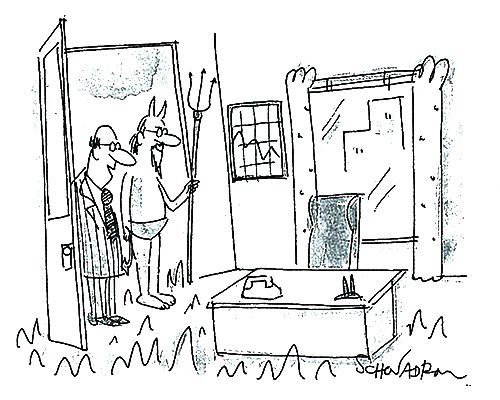

Cover Collection: Hop on a Bike!
It’s as true today as it was in 1934. Nothing is better on a warm spring day than riding through the neighborhood on your bicycle.

Amos Sewell
June 23, 1951

Albert Staehle
June 23, 1945

Douglas Crockwell
August 16, 1941
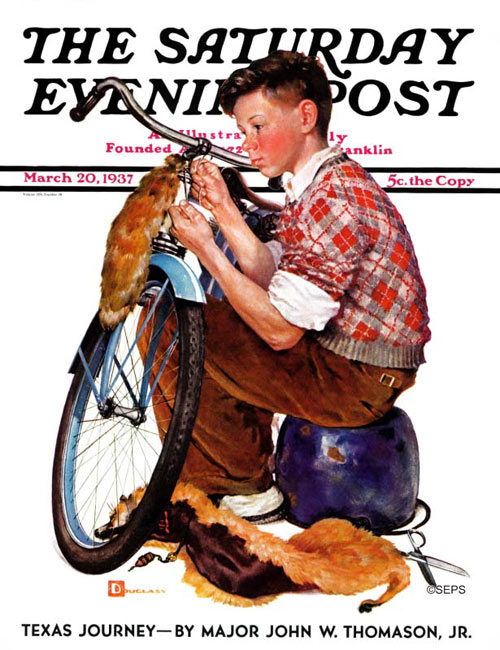
Douglas Crockwell
March 20, 1937

John Newton Howitt
April 28, 1934

George Hughes
June 12, 1954

Thornton Utz
June 18, 1955

Alex Ross
July 24, 1943
The Art of the Post: From the Pages of the Post to Museum Walls
Read all of art critic David Apatoff’s columns here.
The illustrations that appeared in The Saturday Evening Post were intended to last until the next issue came out. The Post was a “periodical,” designed only to fill a period of time until it was updated by a newer issue containing more current information, fashion trends, and merchandise for sale.
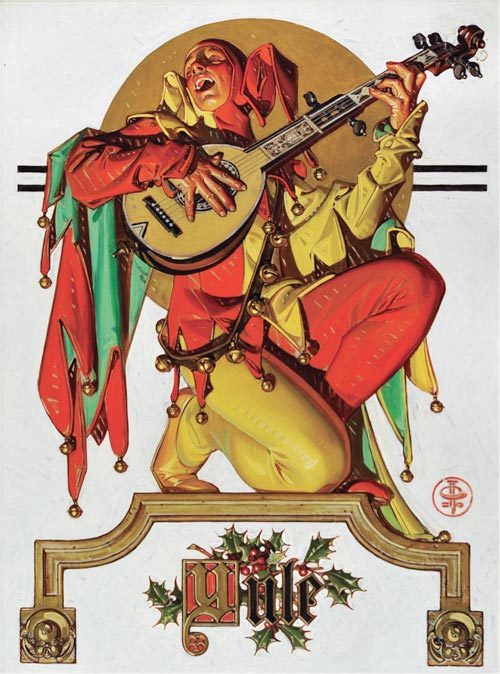
Generations of illustrators created beautiful pictures to fill the Post and other magazines, but it was always understood that they were creating temporary art; one day that thin magazine paper would turn brittle and yellow with age, and eventually crumble and return to mother nature.
It took a while for experts to recognize that illustrations had enduring value, but once Norman Rockwell’s 1951 cover for the Post, “Saying Grace,” sold for $46 million, even the most stubborn nay-sayers realized that this “temporary” art form was worth preserving.

Today illustration art is being rescued and conserved by experts, to take its rightful place on museum walls.
During the decades when Rockwell and other illustrators were exiled from “fine” art, thousands of drawings and paintings were saved from the trash heap by a hardy band of collectors and artists who had the courage to ignore the condescension of highbrow art critics. These collectors weren’t intimidated by labels. Instead, they collected for the best possible reason: they loved the images. Their love of the pure art made them fearless, and they helped preserve the art form in private collections while the experts slowly had a change of heart.
One such collector was Andrew Sordoni III, who started out as a young boy smitten by the art in Sunday comic strips. He liked Dick Tracy and Krazy Kat and a handful of other strips that were delivered to his house in the funny papers. Fortunately, Sordoni’s mother was a fashion illustrator, and she taught him to respect the craft of good drawing. For many years “craftsmanship” was a dirty word in the fine arts community, but it served as a polar star for Sordoni’s collecting. Soon Sordoni began collecting unfashionable illustrators such as Maxfield Parrish. Today Parrish paintings have sold for millions of dollars.
 |
 |
|
U.S. postage stamps featuring comics Dick Tracy and Krazy Kat. (Shutterstock) |
|
A lifetime of collecting has come to fruition in an opening this month of a large exhibition of American illustration art at the Sordoni Art Gallery in Wilkes-Barre, Pennsylvania.

The show, which features one of the great private collections of American illustration, will run from April 7 to May 20, 2018. It was curated by Stanley I. Grand, Ph.D., a professor of art history and expert on the allegorical engravings from Giovanni Battista Ferrari’s De Florum Cultura.
The Sordoni show includes 135 works of art, including a number of illustrations that were originally seen in the pages of the Post, but which now can be seen as the artist created them.


The collection reflects the personal taste of Sordoni, who collected what was once ignored as “lowbrow art.” As the catalog notes, “Andrew found his own way and collected works that were considered of lesser importance at the time, but are now highly regarded both in market and aesthetic terms.”
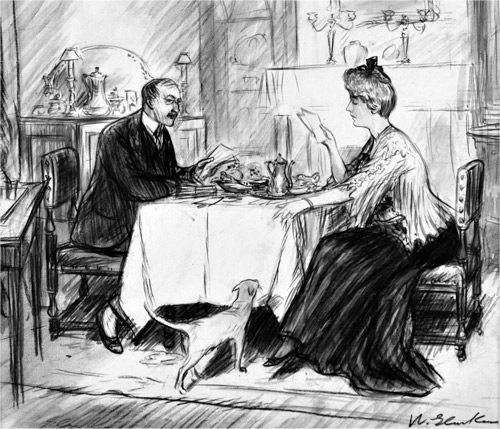

The art in the exhibit includes work by famed illustrators such as Rockwell, Parrish, and N.C. Wyeth. The substantial catalog accompanying the show is a prime example of how critical attention surrounding the field of illustration art has evolved from initial skepticism to serious study by respected academics and biographers who are devoting years and substantial critical analysis to multiple biographies.
While Rockwell was a groundbreaker in being accepted by the “fine” art community, other illustrators whose work appeared in the Post are hot on Rockwell’s heels. Artists such as J.C. Leyendecker, Dean Cornwell, Bernie Fuchs, Robert Fawcett, and others all have their own coffee table art books now, and the value of their original work at auction has increased dramatically. While illustration art was once auctioned in a separate category, much of it is now commingled and sold interchangeably with traditional American “fine” art.
Seriously Good Films to See in May 2018
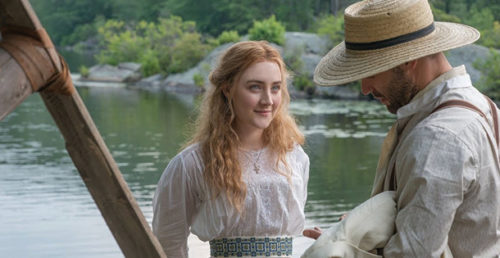
The Seagull (May 11)
Annette Bening, gloriously full-voiced as ever, presides over this lush film version of Anton Chekov’s first major play. She plays a famous but insecure actress, brooding at her lake house outside Moscow and hosting, among others, her bon vivant brother (Brian Dennehey), her super-slick author/boyfriend (Corey Stoll), her playwright son (Billy Howle), and a sweet young neighbor girl (Saoirse Ronan). Everyone here is madly in love with someone who doesn’t love them in return — a situation that starts out comic and ends up quite badly. Every performance is a gem.
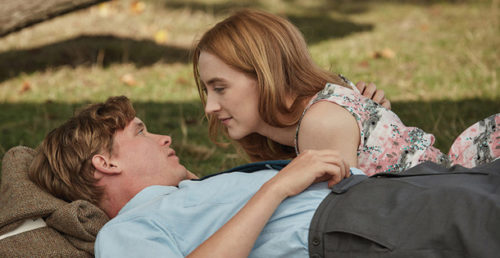
On Chesil Beach (May 18)
Ian McEwan’s film adaptation of his own novel about a naive couple on their honeymoon is a moody masterpiece, capped by haunting performances by Saoirse Ronan (Lady Bird) and Billy Howle — and yes, they’re also paired up in The Seagull, reviewed above. What begins as charming awkwardness descends into blind panic, and soon we’re learning just how mismatched this adorable but doomed pair is.

Won’t You Be My Neighbor? (June 8)
Tom Hanks will play TV’s Mr. Rogers in an upcoming biopic, but there’s no way he’ll match the genuine warmth and unique genius of the real guy, captured in this adoring documentary. Oscar-winning director Morgan Neville (20 Feet from Stardom) dishes no dirt about his subject, but then again, along with Bob “Captain Kangaroo” Keeshan, Fred Rogers may well be one of the few truly unsullied media figures of the past half-century.
For biweekly video reviews of the latest films, go to saturdayeveningpost.com/movies or check out Bill Newcott’s website, moviesfortherestofus.com.
North Country Girl: Chapter 49 — We Turn Outlaw
For more about Gay Haubner’s life in the North Country, read the other chapters in her serialized memoir.
It was time for James and me to leave Mexico and drive back to Chicago. We were far from the gilded, blithe couple of the year before. James now actually looked at bar and restaurant tabs before paying them. The value of his heavily leveraged stock portfolio had plummeted; he was desperate for ready cash.

James had a doctor in Acapulco who wrote him legal prescriptions for Quaaludes. We had gone to see him together the day after we arrived, so James could apologize for his failure to get the doc a gun. A thick layer of dust covered everything in that dingy, one-room medical office, but there was nowhere to sit down anyway. The place stank of body odor and old cigar. James’s doctor was an elderly, bald, and short, his face and skull covered with constellations of brown age spots. Dr. Lude leered at me while kicking his legs about his chair, like a four-year-old at a birthday party. When James tried to push me closer to this hideous imp, I arched my eyebrows in an are-you-kidding look. James shrugged and peeled off twenty dollars from his ever-present roll of American money. Prescription and bill were exchanged, and we headed to the pharmacia next store.

Now, on our last morning in Acapulco, James took off in the Cadillac without a word while I packed up my pink Samsonite. When he returned he announced that he had made one last visit to see his doctor. I wasn’t surprised. I expected that James would want to bring back Quaaludes for himself and to dole out to pretty cocktail waitresses to demonstrate what a cool guy he was.
“Look here,” said James; and there was the glitter and the grit of the old James in his eyes as he handed me his new prescription. I couldn’t decipher the scrawled Spanish, but I clearly saw the number 1,000.
“A thousand Quaaludes?”
James’s doctor had told him that was legally the maximum number of Quaaludes he could prescribe. This obliging doctor also told James that he should fill his prescription at the Rorer factory outside Mexico City, since no local pharmacia carried 1,000 Quaaludes. Quaaludes were forty cents apiece in Mexico. James believed he could sell them in Chicago for four or five dollars a pill.
James claimed that because he had a prescription, possession of Quaaludes, even in that amount, would not be illegal in Mexico. He had also worked out where to hide 1,000 Quaaludes in the Cadillac.
I had been dreading the drive back, the horrors of the Mexican highway, the days filled with cigarette smoke, cassette tapes I never wanted to hear again, and too little food, the nights trying to sleep sitting up. But my heart lifted a little at any reappearance of the old James, even one with such a crazy, pill-in-the-sky dream.
We drove out of Acapulco, James beaming at his cleverness: “The ludes have to be even cheaper than forty cents at the factory. In Chicago, they were at least five dollars apiece when we left. I bet I can get six dollars now.” Not for a minute did I believe that James would be able to buy that many ludes, but for James, that four or five thousand dollars he was going to make was as real as if it were already in his pocket.
We reached Mexico City that evening. James navigated the maze of highways and cobblestone streets to the Zona Rosa, pulled in front of a wedding cake of a hotel, and handed the keys to a waiting valet. James popped for this lovely hotel room and a real dinner, something I had not enjoyed for days. He was preening; he felt he was in control, on the verge of a big score that was even more satisfying because it was illegal.

The next morning, a helpful man at the front desk gave James directions to the industrial suburb where the Rorer factory was, and we were off on what I was sure was a wild goose chase. Within an hour, we pulled up to the gatehouse in front of the immense steel grey factory, distinguished from the surrounding buildings and warehouses by a giant RORER sign. A guard left his post to peer into our car and James whipped out his prescription as if he was showing it to a Walgreen’s pharmacist. The guard shrugged, raised the control bar, and waved us through. I felt a squirt of panic in my guts. We parked; James left the air conditioning and the Mexican radio running for me while he strolled into the building.
I had finally managed to calm myself down when the dark tinted front door swung open and James appeared carrying several cardboard boxes, one stacked on top of the other, a tottering tower of pills. “Pop the trunk,” he called out. With 1,000 ludes in the back of the car and me without a thought in my head that I could bear thinking, we drove and drove through Mexico north, finally stopping at a rundown motel in the border town of Nuevo Laredo.
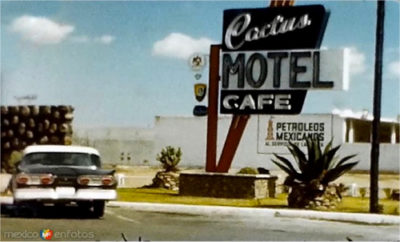
The motel did get American TV, and I spent hours flipping channels, trying to find something to take my mind off the fact that James was busy finding hiding places for a 1,000 Quaaludes in the Cadillac. Whenever I looked out the greasy motel window he would be under the car or disassembling the trunk. James did know his cars. He also thought he knew border crossings well enough to get away with this.
“There is nothing to worry about. The Border Patrol is looking for pot and heroin, not pills,” he said. “There’s been no pot in the car. They can bring in the dogs, there’s nothing for them to sniff out.” And of course, he reminded me, he did have a legal prescription. We were perfectly safe.
James was a degenerate gambler. As he always did while in the midst of a big game, James doubled his bet. At some point while I was watching re-runs of Star Trek and The Mary Tyler Moore Show, James had not only stuffed 1,000 ludes in the Cadillac, he had found someone at the motel to sell him a pound of weed, and made a trip to a hardware store for roll of duct tape.
James put the pot and tape in a brown paper bag, took off his gold chain, ransacked my suitcase for the plainest dress I owned, and told me to swap my contacts for glasses. Thus disguised, we went into the motel office, where James put a five-dollar bill on the counter, asked the startled clerk for the name of the best restaurant in Laredo, on the American side of the border, and to please call a cab to take us there.
The taxi, a rusty and rattling Volkswagen Beetle, came, we hopped in, and James shoved the bag of pot under the back seat. James had become an overnight expert on drug smuggling, always the self-taught man.
“If we’re stopped and searched, and they find the pot, we’re in a cab. A cab is a public conveyance, they can’t prove it’s ours, anyone could have left it there,” as if forgetting a pound of marijuana in a cab were as common a misplacing an umbrella.
At the border crossing, a bored official asked the cab driver where we were going and then waved us through, not even looking in the back seat or asking for our passports. James reached under the seat for the brown paper bag, put it in my purse, and gave me instructions.
It was a nice restaurant. Too bad I couldn’t swallow a bite. While James paid the bill and called a cab to take us back across the border to Mexico, I went to the ladies’ room, locked the door, and got down on my hands and knees under the sink. I took the tape out of the bag, and attached the brown bag to the top of the drain pipe, winding the tape around and around. I crawled back out, stood up, craned my neck from a bunch of angles to make sure nothing was visible under the sink, brushed off my legs, washed my hands, tossed the rest of the tape in the garbage, and went out to where James and the cab were waiting.
The next day, we put on the just-plain-folks clothing from the night before, trying to look as innocent as a twenty-one-year-old blonde and a swarthy forty-three-year-old man in a new model Cadillac El Dorado coming back from Mexico could look. I suggested buying some souvenirs to make us seem even more normal, but the newly expert James said that would draw attention to us: too many people tried to smuggle drugs in piñatas and marionettes.
We looked suspicious enough for the border patrol to give us their full attention at the crossing. We politely stepped out of the car when asked, James opened the trunk and all our suitcases, I dumped out the contents of my purse. The guards walked away for a little conference while James smoked a cigarette. I sweated and had to pee and made up my mind that if we were busted, I would claim that I was a simple Minnesota country girl, being held against my will and forced into a life of deviance and drug smuggling. I practiced crossing my eyes; I could say James was keeping me doped up on those Quaaludes…

“Okay, sir, you’re free to go. Have a nice day.” And with that, we were back in the U.S., with 1,000 Quaaludes somewhere in the Cadillac and a pound of pot to pick up. We stopped at the restaurant from the night before, where James ordered two coffees. I reclaimed our pot in its brown paper bag from under the ladies’ room sink, and we were back on the road.
We had gotten away with it, but our thirty-minute encounter with the Border Patrol had undone me. James was rubbing my leg and complimenting me on keeping my cool, and I was running through everything that could still go terribly wrong. We were in Texas, where the Caddy’s license had already been flagged for guns and white slavery. We had a carload of illegal and semi-legal drugs. And we had thousands of miles and a bunch of other god-forsaken states to cross before we safely home on Oak Street.
My mind suddenly snapped into focus: I told James I needed to go see my mom in Colorado. Like right away. James shrugged and said he didn’t mind doing the rest of the drive by himself. We had been together non-stop for months and needed a break from each other. James pulled into the next rest stop and I called my mom from a pay phone; a recorded message told me that number was no longer in service and gave me a new one. I dialed that one, my mom picked up right away, and I discovered that my mother and her new second husband had moved to Steamboat Springs, where they were renovating a run down ski hostel called the Haystack. I mouthed a silent “shit.” I knew that rathole; I had stayed there once on a ski trip. My mom didn’t have much of a reaction to my announcement that I was coming to visit and didn’t comment on how strained and anxious I must have sounded.
James drove me to the Dallas-Ft. Worth airport, where I bought a ticket to Denver and then onward to Steamboat Springs. A last night together in a real motel with working AC and clean-smelling sheets made me cautiously optimistic that we had gotten away with it. I was almost relaxed, now that I had planned my own escape and James was crowing. No lawful gains could have made him as happy — it was proof that he would always turn up winners, even when faced off against the Border Patrol. During an attention getting airport goodbye, James lifted his face up from mine just long enough to say, “Promise me you’ll be back in Chicago soon.”
7 Ways to Attract Pollinators to Your Garden
Nature’s pollinators, particularly bees, are essential to the balance of life on our planet. Without them our ecosystem would collapse. Wherever you live, you can help support the birds, bees, bats, and even beetles that keep you alive. It all starts in your own garden.
- Plant Native: The pollinators in your local ecosystem have evolved alongside native plants of the region. Of course, these will be different for each region of the country, but the following North American natives enjoy a variety of climates and landscapes:
Purple Coneflower
Aster
Coreopsis
Azalea
Joe Pye Weed
Black-Eyed Susan

- Vary Flower Shapes and Colors: Different types of insects and birds are inclined to pollinate flowers with certain features. Many bees prefer the large landing pads of sunflowers and daisies, while hummingbirds go for the tubular blooms on lilies and foxglove. Planting an assortment of flower shapes and colors will ensure that you please the most pollinators possible.
- Forgo Pesticides: Your best protection against pests in the garden is biodiversity: growing a wide range of plants and shrubs that encourages a healthy, robust habitat for beneficial organisms. Take note that weed killers and insecticides can hurt the pollinators that you depend on for good growth. If you must use one, go for a mild, organic pesticide, and apply it carefully at night when pollinator activity is lower.
- Provide Water: Maybe your garden already sports a birdbath, but bees and butterflies need water too! To hydrate your insect pollinators, you can fill a shallow bowl with stones or marbles along with water togive the bugs a spot to land.
- Make a Bee Hotel: Many of the bees visiting your landscape aren’t “hive” bees, but rather solitary ones like mason bees or leafcutter bees. These natives like to nest in myriad places including the crevices of reeds and bark. A “bee hotel” can be as simple or as ambitious as you’d like. The basic construction consists of a frame filled with hollow bamboo sticks or drilled logs. Try the method offered by Modern Farmer.

- Hang a Hummingbird Feeder: In addition to flowers like lupine, bee balm, and hollyhock, hummingbirds are happy to have a mixture of one part white sugar to four parts water from a hummingbird feeder. These cute backyard favorites are attracted to bright reds, so whether you purchase a feeder or make one yourself, it should don the birds’ favorite color.
- Time Your Garden: Bugs and birds need to eat throughout the warmer months, so you should have flowers blooming all spring, summer, and fall. From the earliest crocuses to rhododendrons, daylilies, sedum and on through sunflowers and sage, a mix of perennials and annuals with staggered flowers will keep pollinators in your yard all year long.